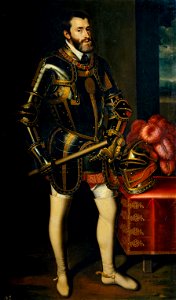A fire that occurred in the pardo palace on march 13, 1604 caused the disappearance of the existing portrait gallery, the work of the best artists of the time: tiziano, antonio moro, alonso sánchez coello and sofonisba anguisciola. Encased in stucco frames on the wall, the portraits in the kings room, organized by sánchez coello on behalf of philip ii, could not be rescued from the fire like other paintings and artistic objects in the palace. Philip iii, aware of the importance of this space as a symbolic place of representation of the monarchy, undertook its reconstruction shortly afterwards, entrusting this mission to juan pantoja de la cruz (c. 1553-1608), a disciple of sánchez coello, who made use of previous models for the recreation of the new portrait room. The effigy of the emperor presided over both galleries, according to the model created by titian, demonstrating that the official image of charles v was already defined, as well as the role that court artists played in its transmission. The use of copies and replicas was a common practice in a society that was unaware of the sense of originality that characterizes the contemporary world, especially in the cutting workshops dedicated to the production of portraits, without diminishing the value of the works. Pantoja's signature on this painting indicating his quality as a translator suggests the consideration that the original deserved, for whom he made the copy and the place where it was going to be installed. Charles v (1500-1558) was the first-born male child of juana i of castile and philip the fair. At a very young age he had inherited through his maternal line the kingdoms of castile, aragon, navarre and its italian possessions, and through his father's line, the dynastic territories of the habsburgs. Crowned emperor of the romans by pope clement vii in 1530 in bologna, he had won notable victories against the turks and protestants, and under his rule, the empire had expanded with the conquest of overseas territories. Titian's success was to define a model that reflected both the physical features of the emperor and his military power and that reconciled the identity of the individual with the concept of imperial dignity that he represented. In this way, the full-length portrait of charles v, armed with sword, baton and helmet, became the official image of power, the starting point of an iconography of enormous fortune in the house of austria, which would reach its full definition in the central years of the 16th century with the portrait of emperor charles v in the battle of mühlberg (p410) and that of philip ii (p411), both today in the museo nacional del prado. Titian accentuated the classicism of the figure of the emperor by assimilating his appearance to that of the roman emperors through the use of a beard, which helped to conceal his pronounced prognathism, and of armor, an essential element in the iconography of the austrians. The medallion of the virgin with child and the golden fleece, symbol of the medieval order of chivalry of the house of burgundy, converted, to this day, into the highest decoration of the hispanic monarchy, express the emperor's commitment to the defense of the catholic faith and religion in the extensive territories of his empire. Pantoja made an image of good technical workmanship, although lacking in expression, in accordance with the character of an iconic emblem that the image of the emperor had acquired for the historical memory of the house of austria (text extracted from ara lázaro, j. In: the spanish portrait in the prado. Del greco a goya, museo nacional del prado, 2006, p. 52). Object Type: painting. Genre: portrait. Date: 1605. Dimensions: height: 183 cm (72 in); width: 110 cm (43.3 in). Medium: oil on canvas. Depicted People: Charles V. Collection: Museo del Prado. Pantoja de la Cruz - El emperador Carlos V
Loading...
